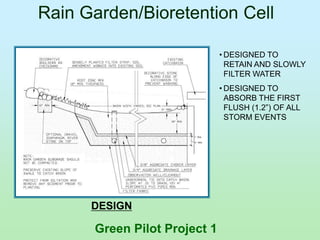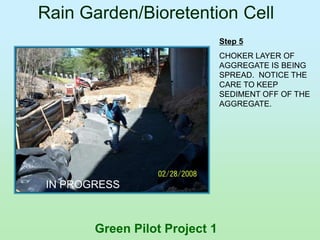Oakland City Rain Garden
- 1. Rain Garden/Bioretention Cell • LOW POINT IN A SMALL WATERSHED AREA - .37 ACRES • LITTLE IMPERVIOUS SURFACE IN WATERSHED • POORLY DRAINED • EXISTING CATCH BASIN BEFORE Green Pilot Project 1
- 2. Rain Garden/Bioretention Cell • FOREBAY OF RIVER STONE TO PREVENT SEDIMENTATION • GRADE REQUIRED BOULDERS TO SHORE UP SLOPE DESIGN Green Pilot Project 1
- 3. Rain Garden/Bioretention Cell • DESIGNED TO RETAIN AND SLOWLY FILTER WATER • DESIGNED TO ABSORB THE FIRST FLUSH (1.2”) OF ALL STORM EVENTS DESIGN Green Pilot Project 1
- 4. Rain Garden/Bioretention Cell TYPICAL CONSTRUCTION SEQUENCE 1. Install sediment control devices as shown on the plans. 2. Grade site to elevations shown on plan. Construct curb openings, and/or remove and replace existing concrete as specified on the plan. Measures should be taken to prohibit drainage from entering construction area. At the end of each workday, all excavations shall be protected by construction safety fencing or temporary backfill as needed. 3. Stabilize grading within Limit of Disturbance except for Bioretention Area itself. 4. Excavate bioretention area to proposed invert depth and scarify the existing soil surfaces, taking care not to compact existing grade. 5. Install underdrain system and observation wells, if specified 6. Backfill with planting soil as shown in the plans and detailed in the specifications, leaving space for the upper layer of mulch. (Overfilling is recommended to account for settlement.) 7. Presoak the soil prior to planting, to allow for settlement. 8. Plant vegetation specified in the planting plan for Bioretention Area. 9. Mulch and install erosion protection at entrance points. Green Pilot Project 1
- 5. Rain Garden/Bioretention Cell Step 1 SEDIMENT CONTROL IN PROGRESS Green Pilot Project 1
- 6. Rain Garden/Bioretention Cell Step 2 EXCAVATION/GRADING IN PROGRESS Green Pilot Project 1
- 7. Rain Garden/Bioretention Cell Step 3 FILTER FABRIC, OBSERVATION WELLS IN PROGRESS Green Pilot Project 1
- 8. Rain Garden/Bioretention Cell Step 4 RIVER STONE FOREBAY IS IN PLACE, DRAIN LINES ARE INSTALLED. FIRST AGGREGATE LAYER IS BEING INSTALLED NOTE: THERE IS NO STORAGE LAYER IN THIS DESIGN. IN PROGRESS Green Pilot Project 1
- 9. Rain Garden/Bioretention Cell Step 5 CHOKER LAYER OF AGGREGATE IS BEING SPREAD. NOTICE THE CARE TO KEEP SEDIMENT OFF OF THE AGGREGATE. IN PROGRESS Green Pilot Project 1
- 10. Rain Garden/Bioretention Cell Step 6 MIXING THE AMENDMENT INTO RESERVED TOPSOIL IN PROGRESS Green Pilot Project 1
- 11. Rain Garden/Bioretention Cell Step 7 PLANTED MARCH/APRIL, 2008 Green Pilot Project 1
- 12. Rain Garden/Bioretention Cell MAY, 2008 Green Pilot Project 1
- 13. Rain Garden/Bioretention Cell SEPT 23, 2009 AFTER THE GREAT FLOOD! NO STANDING WATER Green Pilot Project 1
- 14. Rain Garden/Bioretention Cell JUNE 14, 2010 Green Pilot Project 1














